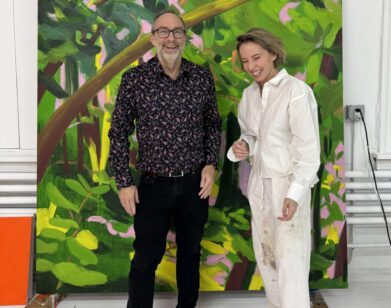The Critic and Cindy Sherman

Untitled, 2010/2012. Color photograph, 64 1/2 x 90 1/2 inches
I’m at the Cindy Sherman opening at Metro Pictures. Jerry Saltz is here too. I know who he is because I’ve read some of his articles. I know what he looks like because of that television show he’s on, the art competition, and even though I haven’t seen it, I have seen a still from the show in which Saltz’s right eyebrow is raised and his head is tipped with critical suggestiveness. At the gallery tonight, he’s having a private conversation when a photographer approaches him to snap a picture. Saltz flashes a quick peace sign and goes right back to his conversation. The move has the whiff of a well-timed cultural ritual, the photographer and Saltz engaged in a smooth, effortless choreography.
I read Saltz’s current feature in New York about “How to Make it in the Art World” and there’s a little sidebar chart that lays out all the trends in new art, one of which is “Cindy Sherman-esque.” From what I can discern about the three images Saltz uses as examples, “Sherman-esque” means theatrical art, art that involves a lot of dress-up and make-believe—the artificial look, the obviously constructed image. Sherman’s not exactly trying to trick you into believing her photos represent reality, but they still trick you. It’s like when you see a picture of Jerry Saltz flashing a peace sign at an opening. You picture him having the sort of night where he’d just casually throw up a peace sign to any passerby, photographer or not. But that’s not true: really, he just throws up a quick one for the photographer and goes back to having his conversation. He’s not trying to trick you, but the photograph is.
The Cindy Sherman photos, on the other hand, have been Photoshopped and manipulated and they don’t try to hide it. Sherman looks like she’s separate from these painted landscapes. She’s in the photo but she’s definitely on top of the backgrounds. And even though the women in the photos have vague relationships to their landscapes, there’s something wrong about the correlation. The connections aren’t real, and the photos are constantly reminding you of that. It’s different from the way Jerry Saltz flashed the peace sign at the camera. Whereas maybe that single action was rehearsed, or habitual, or staged, you couldn’t call the photo inauthentic. Saltz isn’t controlling the photo. All he’s doing is flashing a peace sign (and a smile!): Everything else is up to chance. Like, I noticed how the photographer made the choice to shoot Saltz from a lower angle, which could lead to the double chin effect that lower camera angles encourage—something I’m sure Saltz did not intend. Also, whatever bystander happened to wander behind Saltz is now dragged into the picture. Saltz might not identify with this person, but he is forever linked to them in the Internet’s photo archive. Or maybe one of Saltz’s eyelids is half-closed, giving him that confused/bored/ill expression.
Each one of the Shermans, on the other hand, has a perfect expression. They are immobile and meticulously positioned. All the photos are untitled and the subjects—all women—are nameless. There’s the sick lady living among what looks like a landscape of feces, somewhere near the rocky seaside cliffs around the turn of the 20th century. The one in the Little House on the Prairie garb who wears a homely expression, a Jew fro of tight, maroon curls, and a fat silver ring. The one with the plotting cook and frightened bride on a hilly Scandanavian vista. The woman with a nose job and a kimono-ish robe living on the bayou. The white-trashy one, whose severe haircut and gaze seem out of place amidst the placid rural landscape. The contemporary high-culture one where the art critic is flashing a peace sign at an opening and all those celebrated photographs are hanging on the wall behind him.






